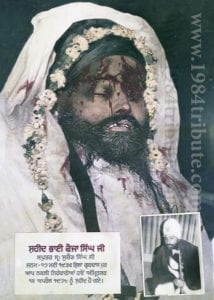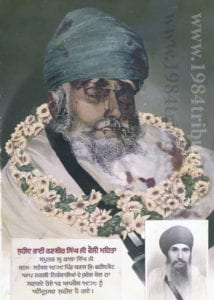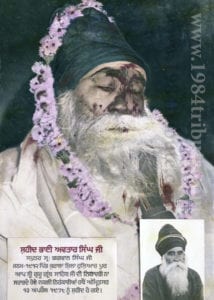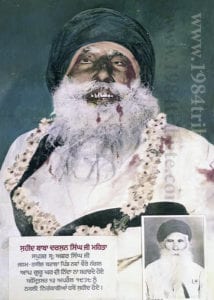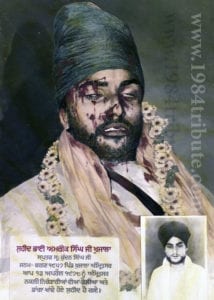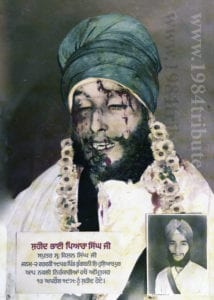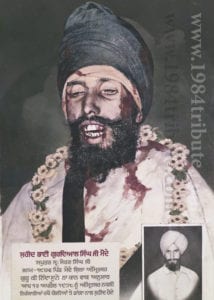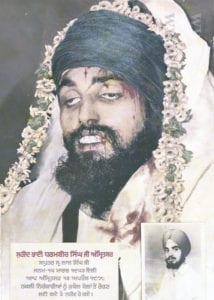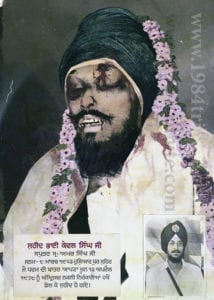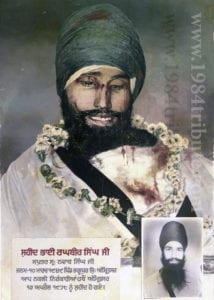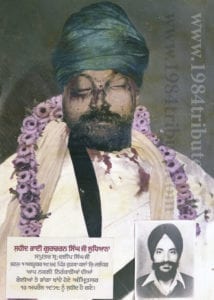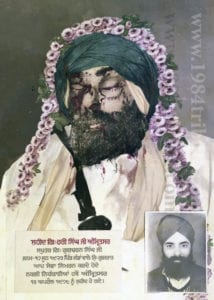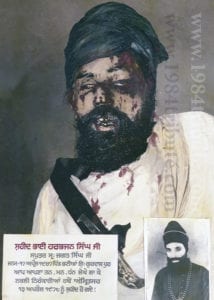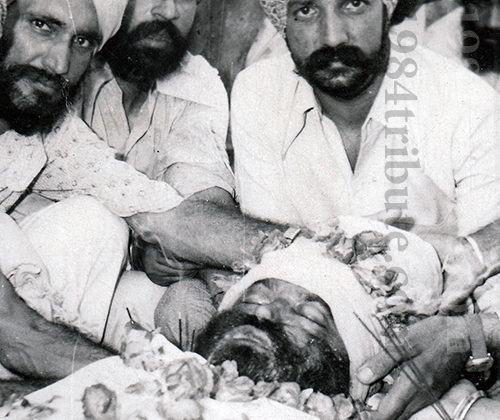1978 April – The Sikh Massacre of Amritsar
1978 April – The Sikh Massacre of Amritsar
The Sikh Massacre of Amritsar in which 13 Sikhs attained martyrdom on the day of Vaisakhi in 1978 is one the biggest and most unforgettable events of Sikh history. These 13 great souls were blessed with martyrdom defending the honour of Sri Guru Granth Sahib Ji Maharaj and are forever remembered for their bravery and courage. In this first section of the book, we will try to explain what occurred on this eventful day.
On 13th April 1978, the Akhand Kirtani Jatha gathered together from all over India at Amritsar to hold their yearly Vaisakhi Smagam. Kirtan had started from Amrit Vela, and all Sikh attendees were blessed with praises of Waheguru. At about 10am, an important message was received. The message said that the followers of Narakhdhari cult leader, Gurbachana were holding a procession in Amritsar and were shouting insulting slogans directed at Sri Guru Granth Sahib Ji Maharaj and the Sikh religion.
The Sangat knew very well that the Narakhdharicult had been doing such things for several years. The Narakhdhari had even gone so far as to give degrading names to prominent Gursikhs including Mata Tripta Ji, Bhai Gurdas Ji, Bibi Nanaki Ji, Baba Buddha Ji, Bhai Lalo Ji and Bhagat Kabir Ji. They scornfully referred to Sri Guru Granth Sahib Ji Maharaj as “a bundle of papers”. The Narakhdhari leader is on record as saying that Sri Guru Gobind Singh Ji Maharaj had made only Panj Pyare (Five Beloved) and that he would make Sat Sitaare (Seven Stars). He had even dared to place his foot upon Sri Guru Granth Sahib Ji Maharaj.
Since 1943 the Narakhdhari cult have annoyed the Sikhs by distorting Gurbani to promote their warped ideals. It was during the 1970’s that the then Narakhdhari leader who refers to himself as ‘Satguru Gurbachan Singh’, went even further. He published articles stating that, Sri Guru Gobind Singh Ji Maharaj was either fighting battles or hunting and that he knew nothing about meditation, that no sensible person can call the writings in the bulky miscellany (referring to Sri Guru Granth Sahib Ji Maharaj) are a divine revelation.
Bhai Fauja Singh heard the news from the loudspeaker when he was kneading the dough for the Langar. He washed his hands and rushed to the congregation. He delivered a short speech, explaining the dire situation and drew a line, asking for those who are willing to accept martyrdom to cross it. Bhai Joginder Singh Talwara asked children and women not to go. However, many women still insisted on going. After performing Ardas, the Gursikhs bowed before Sri Guru Granth Sahib Ji Maharaj and went off to Ramdas Niwas.
Upon reaching Ramdas Niwas they found that the procession had finished. The Gursikhs then decided that they should go to the place where the Narakhdhari cult had gathered, to hold a peaceful but resolute protest against the blasphemous insults directed at Sikh Gurus. It is known that Sikhs of the Akhand Kirtani Jatha and the Damdami Taksal reached the Rigo Bridge near Gobindgarh. Here, the police stopped them. The Gursikhs remonstrated to the police about the insults being shouted at the gathering. These insults could be heard clearly from where they were standing. They told the police that they wanted to protest against the organisers of the gathering and the hurtful insults. A police officer told the Gursikhs that he would go and stop the Narakhdhari cult and for them to remain there. The police officer went to where the Narakhdharis had gathered and the Sikhs waited patiently for thirty minutes for him to return.
On his return there were more policemen accompanying him. DSP Joshi told the assembled Sikh group to go back and that the procession had ended a long time ago. But provoking speeches could still be heard on the loudspeakers. Then about five to six thousand uniformed Narakhdhari rushed towards the group of roughly 200 Sikhs. Within seconds, the massive force of Narakhdharis mercilessly attacked them with pistols, rifles, spears, swords, bow and arrows, sticks, stones, acid bottles and homemade bombs. The Sikhs that were hit with bullets fell to the ground and were brutally butchered with swords, spears and axes. As the ground became covered with the bodies of the dead and wounded, the police fired tear gas and bullets, but even that was directed towards the Sikhs, causing further injuries and death. In this way, the Narakhdhari cult received greater assistance and were emboldened.
Bhai Fauja Singh was fired upon by the Superintendent of Police, who emptied the bullets from his pistol into Bhai Fauja Singh’s chest. These were not the only bullets he was to receive that day, but he kept on standing, uttering only “Waheguru”. Two Sikhs attempted to carry the still breathing and chanting Bhai Fauja Singh to a nearby hospital for emergency treatment, but were quickly arrested by the police. Bhai Fauja Singh’s body was taken by the Police and put into the dead wagon. Again, another Sikh came upon Bhai Fauja Singh and found him breathing and still uttering “Waheguru”. He attempted to help, but half an hour later, when Bibi Amarjit Kaur arrived, Bhai Fauja Singh had attained martyrdom.
DSP Joshi was responsible for shooting Bhai Fauja Singh. He did not allow anyone to provide medical attention to Bhai Fauja Singh. Eventually the police took the bodies of the Sikh martyrs to the morgue. The wounded were taken to hospital.
The astonishing thing is that the gathering of the Narakhdhari cult continued for three-and-a-half hours after this bloody massacre had occurred. It has also become known that the DC of Gurdaspur, Naranjan Singh IAS, and other senior officers were present in the gathering during the massacre. It is clear that the authorities of the Amritsar district allowed the Narakhdhari cult to hold their procession in the Sikhs main city of Amritsar during Vaisakhi. The police authorities are guilty of colluding with and allowing the cult followers complete freedom to kill at will, and not dealing with them properly at the right time.
Dalbir Singh produced a telling eyewitness account. He was a former communist who had devoted himself to trade union activities for more than a decade and is one of many who believe that the Narakhdharis had fought the Sikhs with a pre-conceived plan. At the time of the clash he was a correspondent at The Tribune based in Amritsar. Dalbir Singh maintains that the local administration had allowed the main culprits to escape. His report states:
“It was the afternoon of 13th April 1978. I had returned home from a routine walk around Amritsar. I was taking a nap after lunch when the telephone rang. Someone who refused to identify himself told me that several people had been killed during a shooting incident at the Narakhdhari convention. I rushed out to the stadium at the railway colony.
There were many dead bodies that were strewn outside the venue of the convention. I didn’t yet know what had happened. I wandered around and met Govind Singh, the son-in-law of the Narakhdhari leader, on the stage. Govind Singh first led me to a tent in which there were many armed persons. After entering it, he suddenly turned around to lead me to another tent in which some Narakhdhari followers were chatting with the Deputy Superintendent of Police.
I approached him and explained that I had seen some armed men who might have been the killers. The officer completely ignored this information. The next day, the police searched the Narakhdhari centre in Amritsar for the killers and their weapons. They had let the killers scatter, when they could still have been nearby, only to catch scapegoats one day after the actual incident.”
The government produced a panel of doctors for the post mortem of the dead bodies. It has become known that Mr Janjooha DC ordered the post mortems to be done only by one doctor and the government orders were not correctly carried out. The DC was also involved with the Narakhdhari cult. The press also printed the news details of the incident incorrectly. The Sikh protestors of the Akhand Kirtani Jatha and the Damdami Taksal were called fanatics by newspaper editors, such as Lala Jagat Narain of Hind Samachar. Harbhajan Singh Yogi respond stated:
“Today I read the newspaper report in which it was said, ‘a body of fanatic Sikh’. If doing Kirtan and defending the good name of our father Sri Guru Gobind Singh Ji Maharaj makes us fanatics, then we welcome this allegation. Remember, those who do not defend the honour of their father are never worthy of respect on earth. These martyrs of Amritsar have shown us that we shall live in dignity, if it is not possible, we choose to die with honour.”
The killing of the Sikhs by the Narakhdhari cult leader Gurbachana was a heinous crime. We ask from where and from who did the arsenal of weapons come from? By giving the order to kill the leader of the Narakhdhari cult was the main guilty party of the bloody massacre and should have been punished according to the full weight of the law. However, the Indian government administration, its police and judiciary, were exposed as partners to the Narakhdharis and guilty of failing to deliver justice.
The Sikh Massacre of Amritsar set alight the flames of justice in the Sikh Panth by the martyrdom of thirteen Gursikhs and many more wounded. Many of them left behind wives and children. The Sikh Panth will always remember the thirteen Shaheeds, as well as their great sacrifice.
The funeral took place on Saturday 15th April 1978 outside Gurdwara Ramsar Sahib, in front of a congregation of about twenty-five to thirty thousand people. The thirteen martyrs were united on a single funeral pyre, to be cremated together. The fire of the cremation will continue to burn until Sikhs secure the safety of Sikhi and Sikhs.
